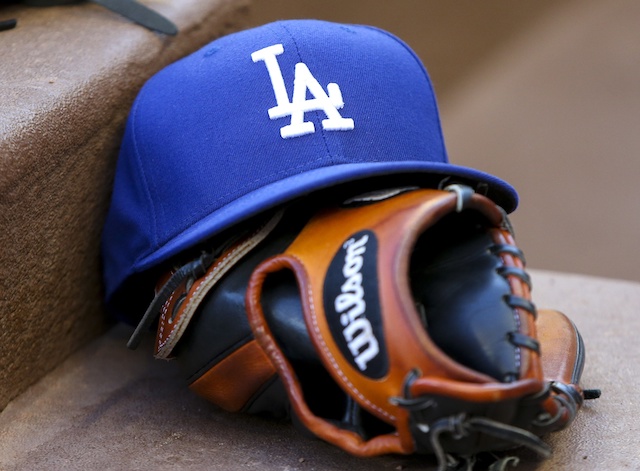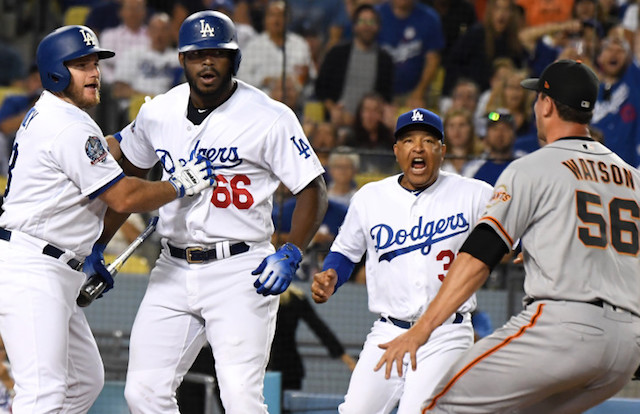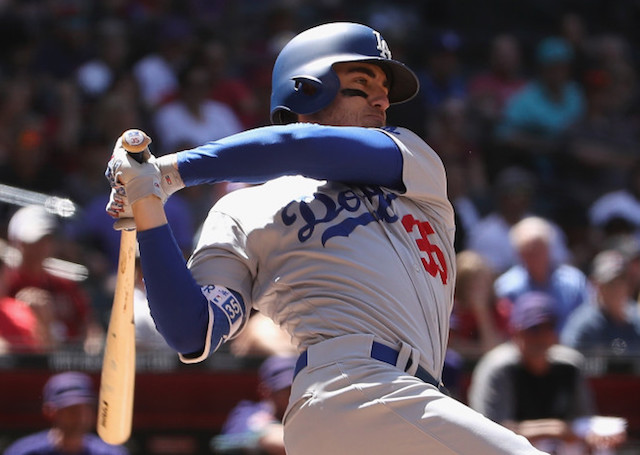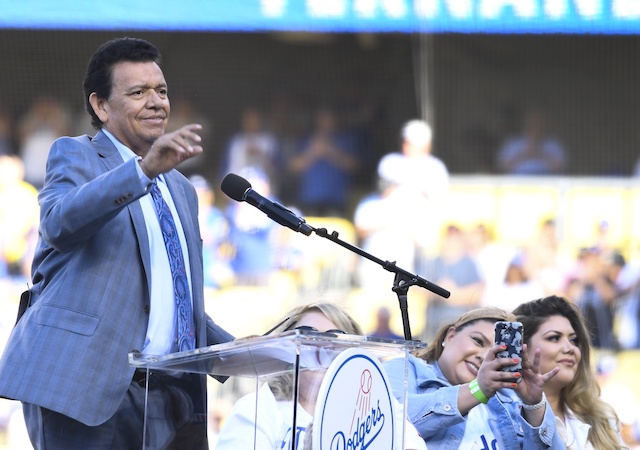Ben Badler of Baseball America recently reported that Major League Baseball is considering implementing an international draft as soon as next year or 2021.
Badler, considered the point person on all things Latin America and specifically international free agency, reports that the owners are in favor of an international draft, and would prefer to do get it done before the current collective bargaining agreement expires after 2021.
However, doing this would require the MLB Players Association to sign off on it as well. Although, since the players are known to be largely unhappy with the current CBA, it isn’t a stretch to think that the owners could throw them a bone on an issue they care more about, such as service time requirements for free agency, and get this done.
While there are positives and negatives to potentially implementing such a system, the focus here is how an international draft might affect the Los Angeles Dodgers, rather than delve into the morality of the international draft, or drafts in general.
First off, let’s talk about the current proposal that’s highlighted in Badler’s article, linked above.
Based on what MLB told team personnel yesterday, the most recent draft concept would be 20 rounds, with teams allowed to trade picks. Every pick would have a hard slot value, so if a team drafts a player and the slot value is $1 million, that player would sign for $1 million. Picks in the top three rounds would be protected for clubs, so if a team drafted a player in one of those rounds who didn’t sign, it would potentially receive compensation in the following year’s draft.
After the 20th round, teams can sign nondrafted free agents for up to $25,000. The age when players become eligible to sign would still be 16. However, while the current system centers around July 2, the annual opening of the international signing period, the draft would be held in August.
One of the bigger twists in MLB’s latest draft concept is the draft order. Instead of replicating the order of the June draft, which would reward the team with the worst record the previous season with two No. 1 overall draft picks, the teams picking at the top of the draft would rotate annually by division. So one year, for example, the teams in the National League East would get the top five overall picks. The next year another division would get the top five picks, and it would rotate every six years.
Going step by step in analyzing the proposal, 20 rounds seems like a solid number for the international draft, as the Dodgers currently have 27 players signed so far during this current period.
Unlike the MLB Amateur Draft, where American, Canadian, and Puerto Rican amateurs are selected, the international draft would include hard capped slots, which means players cannot negotiate their signing bonuses with the teams that select them.
This process is more similar to the ones used in other professional spots leagues. This particular section of the proposal has already received some scrutiny, and it will likely be one of the key discussion points during talks to implement the international draft.
Picks from the top three rounds are similarly protected in the amateur draft, so that shouldn’t be a contentious point.
While limiting undrafted players to just $25,000 or less seems like a stretch, it wouldn’t change a ton from the process now, as not many more than twenty or so players receive more than that every year, per team.
Moving the draft to August doesn’t do very much either, though it may place international players a little more behind in the developmental process than they are now. Under the current system, players can start visiting team complexes six months prior to the annual July 2 opening of the new signing period.
With many of these players already agreeing to handshake deals with teams, this new format wouldn’t allow them the same privileges, since they wouldn’t know which team they’d be headed to until August.
And finally, we’ve got the draft order. MLB wants to seemingly rotate by division every year for the international draft, which seems counterintuitive, because it neither enhances competitive balance nor rewards winning.
One could argue that rotating by division would, in fact, promote competitive balance, and while it may appear so on the surface, the reality is that not every year’s crop of amateur international talent is going to be equal.
Rewarding certain clubs with top picks in a stacked class just because it was their turn to go first simply doesn’t seem like a fair idea.
How This All Affects the Dodgers
Let’s begin by stating the obvious: with an international draft in place, the Dodgers would not have the same access to acquire top flight amateur international talent as they have in previous years.
After signing Diego Cartaya and Luis Rodriguez, two consensus top five players in their respective classes, each of the past two years, the Dodgers were additionally expected to sign Wilman Diaz, who FanGraphs named as one of the seven elite players in next year’s class.
If the international draft were to be implemented next year, it’s unlikely the Dodgers would be able to get Wilman Diaz, a Venezuelan SS and one of the top players in the class.
Diaz is expected to sign with the Dodgers should the system remain the same.
— Future Dodgers (@FutureDodgers) July 17, 2019
Diaz is a 6’2 shortstop, who, like Cartaya and Rodriguez, comes from Venezuela, and you can see video of him here.
Since hiring Ismael Cruz away from the Toronto Blue Jays as the team’s vice president of international scouting, the Dodgers have nabbed top of the class players in each of the years they weren’t restrained, and in Cruz’s last two classes in Toronto, he signed Vlad Guerrero Jr. and Franklin Barreto, two more top of the class talents.
Needless to say, with Cruz at the helm and no type of draft to restrict the available pool of players, one could infer that the Dodgers, unrestrained, might continue to get this kind of talent year after year. Now, however, it looks like that might be coming to an end.
An international draft would place the Dodgers and every other team on a closer-to-level playing field, removing some of the organizational advantage the team currently maintains. However, recent developments may indicate the Dodgers are once again trying to game the system.
Kristian Cardozo, a top 25 prospect in the class on both MLB.com and FanGraphs, who was already considered a Dodger, strangely signed with the Seattle Mariners instead. Not only was Cardozo listed on the Dodgers’ official transactions log, he was written up by yours truly a couple weeks ago, and had already been at their Dominican complex.
So, what in the world happened? No official reason has been reported, so this is where we descend into pure speculation (it’s possible that the situation was injury or contract related, but we have no way to know either way).
Cardozo was listed on the teams’ transactions log and everything, so this is confusing. Although it’d be very Dodgers-esque to try to corner the market on international guys who don’t wanna be hard capped to a team they don’t want.
— Future Dodgers (@FutureDodgers) July 21, 2019
With rumors of an international draft as soon as next year looming, it’s possible the Dodgers may try to go after some of the top players’ from next year’s class who don’t want to be entered into the draft, potentially including Diaz.
Most, if not all, of the top players will turn 16 during this current period, making them eligible to sign before the period ends in June 2020. But why would a player want to avoid the draft?
Badler said the draft proposal includes hard capped slots, so I think the idea there is that if a prospect prefers the certainty of negotiated money X with team Y over unknown hard capped slot money with an unknown team, they can sign in this current period and avoid the draft.
— Future Dodgers (@FutureDodgers) July 21, 2019
With the international draft comes a lot of uncertainty for a system that simply isn’t used to it. In the past several years, most of the top prospects have agreed to deals several years before they’re even old enough to put pen to paper, and these deals are known throughout the baseball world and even the media months before July 2 comes.
Players, and more importantly, their trainers (who really control the whole process), have grown accustomed to negotiating their landing spots and signing bonuses, neither of which would really be possible in a draft with hard-capped slot, unless players start threatening not to sign.
That option, however, would really only be available to the top prospects, whose value wouldn’t decrease significantly by waiting a year to sign.
We know nothing for sure on what happened with the Cardozo deal. But ask yourself: would it sound like the Dodgers to try to outsmart the system and sign a bunch of top players, in the last year when they’ll have the opportunity to do so?
This is the same team and same front office contingent that blew past their international bonus pool in 2015 in historic fashion, on the way to spending roughly $100 million, with half of that just going to taxes on their bonus overage.
They’re not able to spend more than their available bonus pool space this time, but they can trade for up to 160% of it; meaning they can turn their $4.821 million pool into up to $7.714 million.
Adding another nearly three million dollars would surely be enough to sign a top 2020 player, and that’s without factoring in the money allocated to Cardozo; though let’s assume it was similar to the $595K he received from Seattle.
There have been a ton of trades involving international bonus pool space over the last couple seasons, and the Dodgers themselves even acquired some in the Dylan Floro trade, so it certainly wouldn’t be unprecedented.
And just to reiterate: there’s nothing so far besides the Cardozo situation that would indicate the Dodgers are doing this. And, there’s no guarantee there will even be a international draft next year
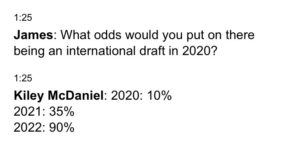
That’s Kiley McDaniel, one of FanGraphs’ reporters for prospects (and one of the best and most well connected in the industry) giving his odds for an international draft, and that’s even after the recent Badler report.
So, even when we think that gaming the system might fit the Dodgers’ MO, there might not even be a system to game, at least not yet.
One other option for spending some extra international pool space this year could be going after Japanese teenager Rouki Sasaki. He is the best Japanese prospect since Shohei Ohtani, and has already touched 101 with his fastball.
The Dodgers have scouted him, and may hope to recruit him away from the NPB in the offseason, like they nearly did with Ohtani years ago.
Not If, But When
At this point, it’s kind of starting to look like an international draft will be implemented, and the real questions are just when it will come into practice, and what the parameters will be.
There’s no doubt that an international draft like the one MLB is currently proposing, or drafts in general really, are anti-labor and serve to benefit the owners by placing an artificial cap on the market value of amateur players.
https://twitter.com/cdgoldstein/status/1151585510143537158
Goldstein, the editor at Baseball Prospectus, hit the nail right on the head. The Players Association can and should be opposed to a draft that further reduces the kind of money amateurs can get at pretty much the only time they’ll have leverage until they reach free agency.
And for the players who never actually manage to reach free agency, this is the only time they’ll be able to have any leverage whatsoever; the proposal on the table eliminates that leverage entirely.
And while the many players think they’ve got a raw deal with the current CBA (and they’re not wrong), ESPN’s Buster Olney explains why they do have some leverage:
The union possesses enormous negotiation leverage right now, because if Major League Baseball is to institute the changes that it believes are necessary to improve its product, it needs the players. If there is going to be an international draft, the union must agree. If the festering problem of tanking is to be dealt with — and there are plenty of folks on the team side who want changes on that front — that can only happen through negotiated terms. The impact of the last CBA has been disastrous for the union, but it stands to reason that some of the lost financial ground can be recovered in the upcoming talks.
The beauty of the CBA is that the players must agree to these big changes and provisions, and the owners and league office can’t just unilaterally dictate the terms of the game. So, if, and likely when an international draft is instituted, there’s hope that the final terms will look a lot better for amateur players than those leaked in the initial proposal.
When the international draft comes, the Dodgers will indeed lose some of their vaunted organizational advantage, and they will almost certainly no longer be able to add top-of-the-class players to their system year in and year out.
But, if they can continue to bring in and develop talent like they have been since the Andrew Friedman regime took over, they might not miss a beat.



